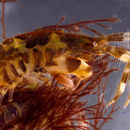Jassa marmorata
provided by wikipedia EN
Jassa marmorata is a species of tube-building amphipod. It is native to the northeast Atlantic Ocean but has been introduced into northeast Asia. J. marmorata are greyish in colour with reddish brown markings. The can grow to a length of up to 10 millimetres (0.39 in). They are generally found in fouling communities and intertidal areas where they build tubes of detritus and algae fragments using silky mucus secretions.[1][2][3] They are remarkable for having two distinct morphs of males with two different mating strategies. The 'major' morphs are fighter males, while the 'minor' morphs are sneaker males.[4]
J. marmorata is classified under the genus Jassa of the family Ischyroceridae. They are commonly confused with the closely related scud (Jassa falcata).[5]
References
-
^ R. L. Lord. "Crustaceans found in Guernsey marine waters including barnacles; copepods; ostracods; malacostracans (cumaceans, tanaids, mysids, isopods, amphipods, and decapods (shrimp/prawns, lobsters, anomurans, and crabs)". SmugMug. Retrieved February 6, 2012.
-
^ Mario de Kluijver; Sarita Ingalsuo. "Jassa marmorata". Macrobenthos of the North Sea – Crustacea. Marine Species Identification Portal. Retrieved February 6, 2012.
-
^ Jocelyn Nelson. "Jassa marmorata Holmes, 1905". Marine Biodiversity of British Columbia, LifeDesks. Archived from the original on April 15, 2013. Retrieved February 6, 2012.
-
^ Josepha P. Kurdziel; L. Lacey Knowles (2002). "The mechanisms of morph determination in the amphipod Jassa: implications for the evolution of alternative male phenotypes". Proceedings of the Royal Society B: Biological Sciences. 269 (1502): 1749–1754. doi:10.1098/rspb.2002.2089. JSTOR 3067827. PMC 1691093. PMID 12350261.
-
^ J. Lowry, M. Costello, D. Bellan-Santini (2011). Lowry J (ed.). "Jassa marmorata Holmes, 1905". World Amphipoda database. World Register of Marine Species. Retrieved February 6, 2012.

- license
- cc-by-sa-3.0
- copyright
- Wikipedia authors and editors
Jassa marmorata: Brief Summary
provided by wikipedia EN
Jassa marmorata is a species of tube-building amphipod. It is native to the northeast Atlantic Ocean but has been introduced into northeast Asia. J. marmorata are greyish in colour with reddish brown markings. The can grow to a length of up to 10 millimetres (0.39 in). They are generally found in fouling communities and intertidal areas where they build tubes of detritus and algae fragments using silky mucus secretions. They are remarkable for having two distinct morphs of males with two different mating strategies. The 'major' morphs are fighter males, while the 'minor' morphs are sneaker males.
J. marmorata is classified under the genus Jassa of the family Ischyroceridae. They are commonly confused with the closely related scud (Jassa falcata).
- license
- cc-by-sa-3.0
- copyright
- Wikipedia authors and editors
Diet
provided by World Register of Marine Species
Feeds on small crustaceans and ostracods.
North-West Atlantic Ocean species (NWARMS)
- license
- cc-by-4.0
- copyright
- WoRMS Editorial Board
Distribution
provided by World Register of Marine Species
Newfoundland to Florida and Texas; British Columbia to s. California; southern Gaspe waters (Baie des Chaleurs, Gaspe Bay to American, Orphan and Bradelle banks; eastern boundary: eastern Bradelle Valley), Magdalen Islands (from eastern Bradelle valley to the west, as far as Cape North, including the Cape Breton Channel), upper Laurentian Channel (bathyal zone)(=Esquiman Channel); southwestern slope of NL; Cobscook Bay
North-West Atlantic Ocean species (NWARMS)
- license
- cc-by-4.0
- copyright
- WoRMS Editorial Board
Distribution
provided by World Register of Marine Species
Probably more widespread
Hayward, P.J. & J.S. Ryland (Eds.). (1990). The marine fauna of the British Isles and North-West Europe: 1. Introduction and protozoans to arthropods. Clarendon Press: Oxford, UK. 627 pp.
- license
- cc-by-4.0
- copyright
- WoRMS Editorial Board
Distribution
provided by World Register of Marine Species
Jassa marmorata is expected to occur in all marine tidal water of the Delta area.
Faasse, M.; Van Moorsel, G. (2000). Nieuwe en minder bekende vlokreeftjes van sublitorale harde bodems in het Deltagebied (Crustacea: Amphipoda: Gammaridea) [New and lesser-known amphipods of hard substrates in the Delta area of the Netherlands (Crustacea: Amphipoda: Gammaridea)]. Ned. Faunist. Meded. 11: 19-44
- license
- cc-by-4.0
- copyright
- WoRMS Editorial Board
Habitat
provided by World Register of Marine Species
Found from the intertidal zone to 20 m depth, in tubes on pilings, wharves, buoys, eelgrass and hydroid stems.
North-West Atlantic Ocean species (NWARMS)
- license
- cc-by-4.0
- copyright
- WoRMS Editorial Board
Identification
provided by World Register of Marine Species
A lot of Dutch material was in the past wrongly determined as Jassa falcata. Of this species only one is recorded in the Delta are. According to Conlan (1990) J. herdmanni and J. marmorata are more common on the hard substrat of the Delta area.
Faasse, M.; Van Moorsel, G. (2000). Nieuwe en minder bekende vlokreeftjes van sublitorale harde bodems in het Deltagebied (Crustacea: Amphipoda: Gammaridea) [New and lesser-known amphipods of hard substrates in the Delta area of the Netherlands (Crustacea: Amphipoda: Gammaridea)]. Ned. Faunist. Meded. 11: 19-44
- license
- cc-by-4.0
- copyright
- WoRMS Editorial Board

